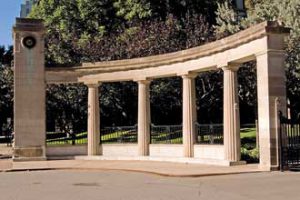
By Allyson Rowley
Keep your ears peeled on October 1. You may hear something amazing: bells chiming at the Roddick Gates. Equally amazing: For the first time in living memory, the four clocks will actually be working.
“I have wanted to see the clocks and bells working for 57 years,” said McGill graduate Dr. Joseph Hanaway (BA ’56, MDCM ’60). A retired neurologist from Missouri, Hanaway has spent the past four years meticulously researching the history of the clock tower. He discovered Birks of Canada had supplied the original mechanisms when the Roddick Gates were erected on Aug. 25, 1925. Working with a Birks representative, Hanaway tracked down a clockmaker in the Boston area who was able to repair the historic machinery.
So, shortly after the 85th anniversary of the Roddick Gates, the clocks and bells will be re-started at a ceremony at 4:30 p.m. on Oct. 1. The clocks will be water-sealed and satellite-controlled (no more scurrying up the tower to fix a clock that might have gone awry after a thunderstorm), and the bells will be computerized so they can be set to ring on any schedule and at any volume. The tower’s battered bronze door will also be replaced with a shiny new one.
“It’s an iconic location for the whole university,” said Jim Nicell, Associate Vice-Principal (University Services). His building operations staff, led by Gilles McSween, have replaced the ancient electrical wiring and have taken care of numerous other structural upgrades, in preparation for the installation of the new clocks and computer controls. Nicell mentions the project is in keeping with many other recent efforts by his team “to restore elements of the downtown campus to its former glory.”
Hanaway is well-acquainted with McGill in all its glory. As a fourth-year medical student, he wrote a history of McGill’s coat of arms; he is co-author with Richard Cruess of two volumes of McGill Medicine (McGill-Queen’s University Press); and Hanaway wrote the biography of Sir Thomas Roddick for the Dictionary of Canadian Biography.
“He was a punctuality fanatic,” Hanaway said of Roddick. “He’d arrive at a lecture three or four minutes early, wait, and then walk through the door on the dot.” McGill’s Dean of Medicine from 1901-08, Roddick was a renowned surgeon who pioneered the use of antisepsis, and who also worked tirelessly to ensure shared qualifications across Canada for the practice of medicine. The Roddick Gates were constructed in his memory with a gift from his widow Amy.
What motivated Hanaway to contribute so many hours to this project? “You might say its payback for my great experience at McGill.”
With files from Laurence Miall.
